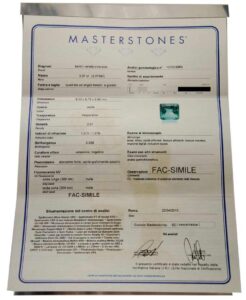Colored gems are classified indicating mineralogical kind and variety (10245 UNI LAWS). Identification exclusively depends on the analysis of mineral optic and physic features, which can be observed always and only through gemological instruments. The use of advanced tools as Raman, FT – IR and UV – VIS – NIR spectroscopy aims at the individualization of synthesis or treatment and to the study of the origin.
Mass and dimension
Mass is determined in metrical carats through an extremely precise micro – analytic scale. The value is expressed with five decimals, making the gem easily recognizable through the his weight uniqueness.
Shaping and cutting
Shaping and cutting are determined following 10173 UNI LAW
Refraction Index
Measures the optical density through the refractometer. An only index is reported on the document when gems are mono – refringent. For the bi – refringent gems, the R. I. of the two different refracted rays are indicated. Thanks to the study of the highest and lowest index values behavior, the birefringence entity (already revealed by polar scope) can be expressed and the optical sign established.
Pleochroism
Is revealed by the use of dichroscope, only for bi- refringent gems. The selective light absorption is observed.
BR diametric gems: two possible components colors are indicated.
BR trimetric gems: three possible component colors are indicated.
Furthermore, the entity of the observed colors difference is indicated by the following definitions: Weak – Average – Strong.
Density
Determined by hydro – static scale. It is indicated with almost two decimals.
Fluorescence
The sample undergoes UV long (356 nm) and short (254 nm) radiations released by a Wood lamp. Intensity (weak – medium and strong) and color are indicated in the document. The word “none” means that the gem is inert.
Absorption spectrum
The use of reticulum spectroscope enables to indicate wavelength or their intervals absorbed by gem, lightened by a transmitted light through an optical fiber. Absorptions are indicated by black lines or color groups on a diagram showing wavelengths on the visible spectrum. Through the use of UV – VIS spectroscopy, the results gained by spectroscope are electronically confirmed. Data concerning absorptions in the ultra – violet region, sometimes really important for the revelation of possible treatments, are added in this phase.
Inclusions
Gems are observed through a vertical microscope in dark field and through horizontal microscope after being immerged in benzyl benzoate or bi – methane (methylene iodide). The gem internal features (liquid, crystalline and structural inclusions) are described on the analysis document. The recognition of inclusions typical of the different varieties of gems, either natural or synthetic, is generally fundamental for diagnosis. The most important inclusions for the nature evaluation are microscopically screened and filed together with a copy of issued documents.
Observations
In this section the possible gem treatments (thermic treatment, splits or holes fillings with foreign material) are described by indicating the entity of the artificial adornment. Microscopic observation of the typical inclusion modification, the shortwaves fluorescence, the crossing of data gained through FT – IR, Raman, UV–VIS–NIR spectrometer exams are will show whether the examined gem underwent artificial adornment processes. Possible revealed treatments are clearly shown on the analysis document, complying with the LMHC (Laboratory Manual Harmonization Committee) guidelines.
Filing
The analysis document drafts leads to the creation of a folder comprehending different documents during exam. Such documents are signed by analysts with maximum secrecy. The folder has the same number as the analysis certificate and can, therefore, be easily tracked down. We need to point out that the documents do not show the name of applicant. In order to ensure a bigger analysis documents integrity, applicants can check their own document entering its number.
***
Every analysis document concerning colored gems has a picture of the examined gem and is signed by almost two analysts

